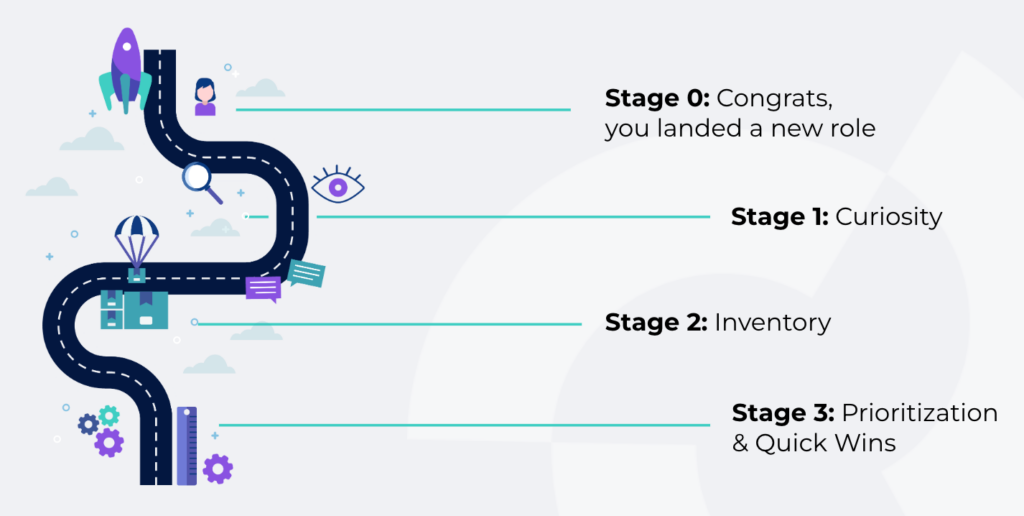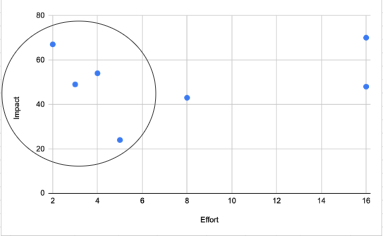Guest post from Maria Van Wambeke, Product Operations’ evangelist and Product Ops HQ community advocate.
Starting confidently in a new Product Operations (Product Ops) Leadership role can feel overwhelming, especially considering the breadth of responsibilities within typically small Product Ops teams. Without a pragmatic approach, it’s challenging to pinpoint where your efforts will have the most significant impact. In this blog post, we’ll explore the challenges faced by newcomers to the role of Product Ops Leader within an organization.
The First 90-Day Framework is a failproof guide for navigating your first days. Whether you’re an expert or a newcomer, following this blueprint will deepen your understanding of the organization, its teams, and the critical programs. By maximizing your efforts and focusing on high-impact initiatives and tasks, you’ll accelerate your journey to becoming a Product Ops master.
What is Product Operations?
Before we dive into the tactical plan, let’s set the stage with a general “fits most” definition of what Product Ops is. The vastness of responsibilities makes creating effective repeatable processes even more critical. You need to scale your team and yourself.

Let’s quickly describe each area. Product Operations is:
- The glue between functions & teams, ensuring that cross-functional communication and alignment are proactively built into processes.
- Aligning product priorities to what matters most to the organization with global prioritization spread across multiple teams and roadmaps. OKRs, KPIs, and Value Streams are methodologies that enable this.
- Streamlining routine tasks for Product Managers through ownership and management of the product data strategy, tech stack, frameworks, and templates, to name a few. The result is often “giving time back” to PMs so they can focus on creating customer value.
- Product Manager optimization and excellence through onboarding, empowerment, and coaching so that PMs can be most effective in their roles.
- Creating value for the organization through continuous process improvements and standard operating procedures (SOPs) that scale.
- Promoting a discipline of continuous discovery and learning. This includes user, customer, and competitive research as well as testing/experimentation.
- The development and execution of a communications’ strategy including documentation and presentations and ownership of the Product Ops calendar.
- Ownership of the PM tech stack including tool selection, implementation, and management.
The Product Ops charter can vary greatly across organizations, so this is a rough “fits most” definition. I’m interested in hearing what other responsibilities are in your charter. Send me a DM in the Product Ops HQ Slack.
Overview of the First 90-Day Framework for Product Ops Leaders
The First 90-Day Framework can be broken down into 3 stages. Some stages may take longer than a month and you may even approach stages in a different order.
- Stage 1 is the Curiosity Stage. You’re on a mission and this is your learning tour. Before you start implementing any improvements, you need to identify how things are done at the present time, why they are done that way, and to begin discovering what’s working and not working. This deep curiosity and active listening tour helps to make your intentions clear.
- Stage 2 is the Inventory Stage. Now that you have a big-picture understanding of the organization, you are ready to dive into the details by inventorying and baselining workstreams, processes, Standard Operating Procedures (SOPs), data, and information to gauge where improvements may be needed and where they’re needed most.
- Stage 3 is the Prioritization and Quick Wins Stage. In this stage, you’ll master the art of prioritization in the context of what matters most to the organization and identify a few quick wins that you can begin to put in place to evidence the intentions you outlined in Stage 1.

Stage 1: The Curiosity Stage
You are on a learning tour and the organization is your map. You will navigate through a new landscape by meeting with functional leads, stakeholders, and each of your direct product team members with an aim at learning the lay of the land. Ask as many questions as you can, be inquisitive, and take a passenger seat in the conversations.
At this point, you don’t have any political capital, so you are building relationships that will mature into alliances as you progress through your role. You want to connect with as many people as possible to learn from them. You are an advocate for change, but you don’t claim to have all of the answers. This slow and graceful entry into the organization shows that you respect and honor that there is likely a reason behind why things are done a certain way. You are on a mission to learn the why and begin discovering what is working and not working for the organization.
As you are meeting 1:1 with functional leads, stakeholders, and team members, take copious notes. You will likely revisit many of these conversations or have follow-up discussions during subsequent stages of the process. You want to begin building your own rosters so you know who to talk to and when. I suggest developing 3 rosters to start: (1) immediate product team (Product, Engineering Design), (2) functional leads, and (3) stakeholders. This is the start of your alliance building. Listen intently and empathetically to identify pain points and jobs-to-be-done that can be improved. Make lists of workstreams (roadmaps), processes, SOPs, data sets, and any other information that will need to be inventoried in the next stage.
Stage 2: The Inventory Stage
You are approaching this stage with a big-picture view of the organization, how things are done, and why they are done a certain way. In this next stage, you’ll get in the weeds by inventorying and baselining workstreams (roadmaps), processes, SOPs, disparate data sets, and information that will help you to piece together a day in the life of a product manager and other members of the product team (Product, Engineering, Design).

You are working to identify the “Who, What, Why, and How” for the product team and to start forming a narrative or hypothesis about the day in the life of a Product Manager as well as other members of the Product Team. Review all notes from the curiosity stage to begin to identify gaps, duplicates, and variations. Reach back out to the people on your rosters to continue learning, validate findings, and nurture your new relationships.
Stage 3: Prioritization and Quick Wins Stage
Now that you have both a high level and a detailed understanding of the organization, you are ready to take action. In this stage, you’ll master the art and science of prioritization in the context of what matters most to the organization and identify a few quick wins that you can put into place to show evidence of the intentions you outlined in Stage 1.
This is the start of you walking the talk in your new role and when the improvements you implement start to have a material impact (even a small one), you will increase your political capital and earn the right to begin solving more complex challenges with the trust and support of your team.
Step 1 – Translate findings into actionable initiatives for the Products Ops backlog
To kick off, you’ll leverage the massive amount of context you gathered during the previous two stages and translate those findings into actionable initiatives that tie back to the “Who, What, Why, and How” themes of the Product Ops charter (Image 3).
Let me give you a few examples I’ve encountered:
- SOPs, Processes, Templates category – I often hear this pain point from the Design Team: “We are invited to participate in discussions only after design decisions have been made and the proposed solution isn’t always the best for the customer or the most seamless to implement. We need to get involved sooner.” With this pain point, the finding translated into an initiative would read something like this: Review and refine the lifecycle framework to ensure the design team is involved during planning (early) stages.
- PM Toolset / Tech Stack category – In shadowing Product Managers, I discovered the use of a variation of tools for management of backlogs including Excel, Google Sheets, Jira, and GitLab. This finding translated into an initiative could be: Select and implement a universal tool for PMs to manage their product backlogs.

Once the translation exercise is done, you should have a robust Product Ops backlog that you’ll prioritize using a portfolio prioritization framework that is organized by weighted Impact and Effort values. When this framework is applied to the initiatives you identified, you will gain insight into the things you should work on first because they have the highest Impact with the lowest amount of Effort. These are your quick wins.
Step 2 – Develop a weighted prioritization framework and assign Impact values
Now that you have a healthy Product Ops backlog, it’s time to develop a weighted prioritization framework.
- You’ve gained invaluable insight during your learning tour and in studying vision and strategy documentation. You’ll need to determine the Impact variables based on what matters most to the organization. If you are hesitant or lack confidence in deciding on these variables or just want reinforcement that your selections are accurate, re-engage your rosters. This reinforces the intent you started building in Stage 1.
- The framework is broken into two measurement areas to align with the Action Priority Matrix to generate an aggregate score for Impact and one for Effort. Again, high Impact and low Effort is a quick win, so we want to make sure our framework is designed to provide that guidance.
Areas I’ve measured in the past for Impact are customer, financial, competitive, strategic alignment, and market or competitive. For Effort, the simplest measurement is time, but I’ve also added the optional measurement of complexity, to address technical feasibility. - Once your Impact and Effort variables are identified, determine your scale. I use a 10-point for more granularity, but you can also use a 5-point scale with 10 and 5 having the most impact.
- Add your variables as column headers to a spreadsheet. You will then add each of your initiatives to the sheet and begin assigning values. Here’s an example:

“I’ve implemented [this prioritization framework] in Dragonboat to create a single source of truth, which is essential for building standard operating procedures for a day in the life of a PM. Having this ease of use and low friction helps to encourage adoption.”
– Maria Van Wambeke (“Your First 90 Days in a New Product Ops Role” – Product Ops HQ Meetup)

Step 3 – Size initiatives to identify Effort values
To assess the time component of Effort for each initiative, I like to use T-shirt sizing since it’s simple, universally recognized, and easy to understand. You must define your methodology before diving in because you want to normalize the output across initiatives. First, you need to decide on the sizes you’ll use. If you have a ton of initiatives, it’s best to be more granular and use an XS-XL scale that translates into numeric sizes 1-8 using the Fibonacci sequence (see Image 7). If anything is larger than an XL, it will need to be split into smaller initiatives that fit within the scale.

Next, you’ll decide what each size represents in terms of time. Does a numeric value equal a calendar week or a sprint? Since this is the Product Ops backlog, I suggest that you assign the T-shirt sizes to the initiatives yourself and again, “phone a friend” from your rosters if you want to hash out the requirements in more detail.
Now, identify the values for Effort. Effort is made up of time from the T-shirt sizing value and complexity which is a subjective assessment of technical feasibility. Remember, T-shirt sizing is based on an 8-point scale and complexity will be based on a 10-point or 5-point scale, whichever scale you used for your weighted matrix. Add these values to your spreadsheet. If you want to simplify this step, just omit the Complexity variable altogether and your Effort value will be made up of time only.
Step 4 – Plot Impact and Effort to Identify Quick Wins
Once you’ve added weight for all variables in the framework, you can identify the quick wins. Select those that have the highest level of Impact and the lowest level of Effort. The goal, again, is to make an impact as expeditiously as possible to show your unique value. You can always iterate once the MVP is out.
Tip: you can use a tool like Excel to plot the totals in a scatter chart. Initiatives plotted in the upper left quadrant will signify the quick wins.

In Closing
Mastering the intricacies of a new role as a Product Operations Leader is no small feat. However, armed with the First 90-Day Framework outlined in this post, you can confidently navigate the challenges and make a significant early impact within your organization.
By following the stages of Curiosity, Inventory, and Prioritization, you’ll gain a deep understanding of the organization, its processes, and the critical initiatives that you should tackle first. The framework will enable you to identify quick wins and prioritize your efforts effectively, maximizing your contributions from the outset of your role.
Product Operations is a vital function within growing product organizations, serving as the glue that binds teams together by enabling them to scale successfully. It’s more than just a role, it’s a force multiplier, a morale booster, and a key driver of organizational success. So, whether you follow this framework step-by-step or adapt it to fit your specific needs, I hope it serves as a valuable guide in your journey to Product Ops mastery.
I realize that this is a detailed blog post with reference to several frameworks for you to adopt in your role. If anything is unclear, feel free to start a conversation in the Product Ops HQ Slack or reach out to me directly on LinkedIn.
Thank you for reading, and here’s to success in your new role!
Want to discover Maria’s secret weapon? Enter Dragonboat! Our product portfolio management platform empowered her to align product teams around product development and foster innovation through collaborative idea management processes. This enabled Maria to demonstrate impactful results in the initial phase of her role as a Product Ops Leader.
Ready to achieve quick wins, operationalize your vision, and accelerate success, just like Maria? Contact a Dragonboat product expert today and see how they can assist you.



